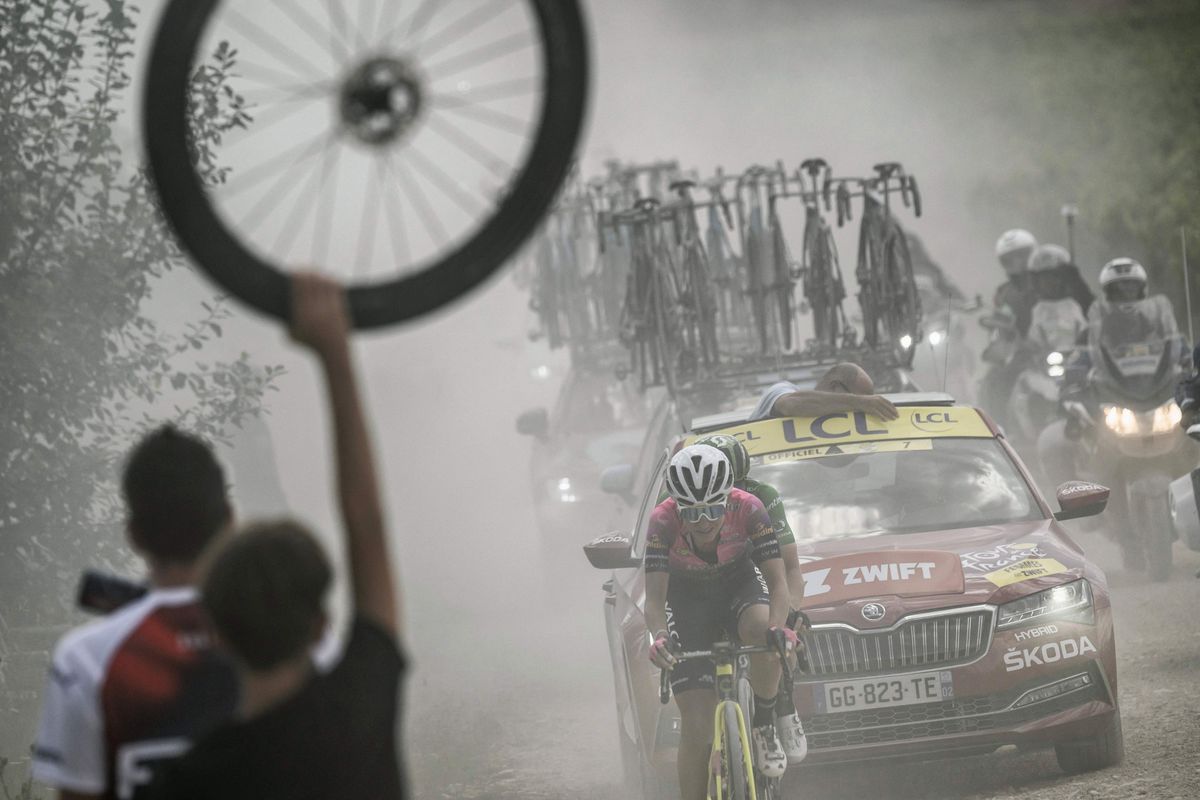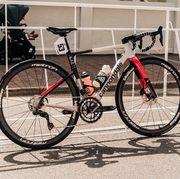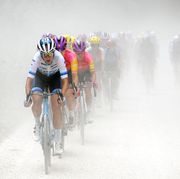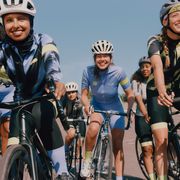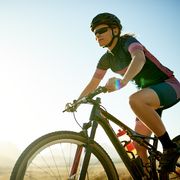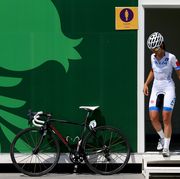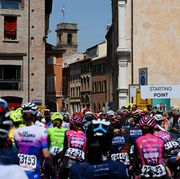- Who: Anna Greetis, race technician for SRAM Road Racing
- Hometown: Chicago, IL
- Favorite Discipline: Gravel and adventure biking
- Favorite Tool: Effetto Mariposa Giustaforza adjustable torque wrench
- Morning Drink: Coffee, black. If I’m feeling fancy, a latte.
Picture this, Stage 4 of the Tour de France Femmes, the dreaded gravel stage, and you are standing on the side of the road after the penultimate gravel sector of the day. You’ve already heard the chaos on the race radio, you got to see the road conditions first-hand, and you know the inevitability of mechanicals and punctures that are headed your way. A cloud of dust approaches and you can hear the taka-taka of the helicopter overhead. Wheel in hand, you stand there waiting as ready as one can be – it’s not your first rodeo, Paris-Roubaix prepped you for this – but it is Kasia Niewiadoma of Canyon // SRAM, your team leader, who finds you in desperate need of a new front wheel. Every second you waste can affect her overall standing, but there is no time to think of that so you say to yourself “Alright, here we go!” and spring into action.
Well, that was Anna Greetis’ case at the TdFF this past July. A moment that was caught on video and shared on Zipp Speed’s Instagram, and while she thinks there is always room for improvement, that speedy wheel change contributed to Niewadoma finishing in the same group as Annemiek van Vleuten (Movistar) that day, and finishing third place overall in the GC.
Greetis is a 30-year-old bike mechanic from Chicago, IL who works as a Race Technician for SRAM Road Racing. For SRAM-sponsored athletes in North America, Greetis is the go-to person for tech questions, gear, and planning orders for the season. In the US crit scene, she works alongside Legion of LA and Miami Blazers, and during cyclocross season, she assists the Trek Factory Team, and Steve Tilford Racing. Plus, a whole pool of individual athletes and privateers in the gravel and triathlon scenes.
Cycling mechanics is a passion Greetis shares with her father, who is an engineer at SRAM. It wasn’t her idea to join her father there, but after years of working in bike shops and mastering her skills as a mechanic, Greetis started looking for a new challenge. So when the role of a Race Tech opened up, she couldn’t resist.
Greetis’ father introduced her to cycling early on, and as a kid, she remembers watching the Tour de France with her dad. Greetis recalled inquiring early on, “Why isn't there a women's tour? Why can't I ride this?” This year, Greetis had the opportunity to work for SRAM at both men’s and women’s Tours de France events, and so we couldn’t pass up the chance to ask her about her experience there, what being a tech is like, and what was the vibe around the revival of the women’s event. Here is what she had to say.
Bicycling: When you saw the turnout at the Tour de France Femmes, did you notice a difference in the crowds that came out for the race?
Greetis: I think it was a really good mix of people. It felt like everybody was out there and having fun. And maybe it was, less of the older guys who just grew up in it and are super fans and are out there for the bidons [water bottles] and stuff. And it seems like there were a lot more families and kids out there. But it's hard to compare, just like what I've seen on TV versus what I'm experienced in person. It wasn't like there wasn't a sense of it being a lesser [event], whether excitement or performance or anything like that. People were thrilled to be watching racing.
What were the gravel sectors like in Stage 4 of the TdFF?
I'm a total gravel rider, and one of the first things I did was walk down the gravel sector because we got there early. So, I walked down the road and checked it out. It was very similar to the gravel I have here at home [in Illinois] where the suburbs end, and a bit further west. I can get into those farm roads and cornfields for ages. The gravel we have up here is like limestone. You got some good compacting, but there are some big bumps and whatnot along the way. And that's exactly what it looked like there [in France,] at least in the third gravel sector of the day. There was one more after it, and there might have been a few rocks slightly bigger than what I would typically see. But it was it is the most similar I'd ever seen. It was your classic little gravel road style, which I would happily ride on a wide tire, but they were riding this on road bikes.
As for tires, what were the trends you saw amongst teams?
It varies from team to team. Basically, all teams were on a slightly wider tire than they would normally ride. A lot of that is just to account for those added bumps along the way and give them a little extra wiggle room to get through the gravel safely.
Zipp Speed posted a video on Instagram where you do a quick wheel change for Kasia Niewiadoma of Canyon//SRAM on Stage 4. A big high-pressure moment, considering she was the team leader. What was that like?
I worked Paris-Roubaix in the spring for the men and the women. And that's another one [bike race] where riders are punishing their bikes and wheels. This felt very similar to that; where you get out there, you have your wheels, you find a good spot to set things up, and then you just hang out and wait.
But as you're hanging out and waiting, you can feel that energy building. And I knew they were coming up the road. You could see the light cloud of dust in the distance and the helicopter getting closer. So, you feel that adrenaline rising, and it's just that moment of “alright, here we go.” I felt something was going to happen, and I had to be ready. And I probably would have had that same feeling, regardless of whether something had happened or not, but you know, it just paid off this time. At the end of the day, what you're there to do is support that rider. So that's the primary focus.
Now that's on video, where would you rate your wheel change?
I think it was pretty good. But there's always room for improvement, right? It's impossible to have the perfect wheel change; there's always going to be something small.
Let’s talk tech. What did you see out there at the Tour? And how many teams are still using tubular vs. tubeless tire setups?
There are still a few teams in the peloton that are on tubulars, and I think a lot of that has to do just with the mentality of cyclists and that transition [into a new technology]. SRAM, as a company, wants to find out what's better and what's faster. Change is key. But change is always hard…you see some people willing to embrace that change, but also people less inclined to do so.
I think the men's peloton is a spicy place for that, right? You've got people who don't like disc brakes and prefer rim brakes. And you've got the same thing with wheels and tires, tubeless versus tubular. And change is scary.
A lot of our [SRAM-sponsored] teams have embraced the [tubeless] technology. And I think a lot of it is having good data to back that up. “Feel” is a big part of cycling, and it's important. But it's also important to look at the data. And it's, it's a matter of merging those two things. Just because something feels right doesn't mean it is correct. Just because what we had [raced in the past] felt normal, doesn't mean that that's the most efficient. It's a similar thing that we're seeing with this technology.
The big thing right now is its wheels, tires, and that combination. I personally run tubeless; I really like it. And my father hasn't quite adapted to it, but we're working on it. You're going to be mad at me for saying that, probably. But, that's part of it. It's a new technology, and it's different. You don't necessarily know all its ins and outs and intricacies. So you don't have that comfort with it. And so there's a degree of like, well, why should I change? And for something like that, this is a great example of it, right? You can hold up to stuff pretty well. But you know, everything always has its pros and cons.
What gear ratios did TdF riders use in the mountain stages?
With the mountain stages, we had a lot of riders on 10x36 [range cassettes]. But it varies a lot. We have some teams that like using a smaller combination of chainring sizes because they're able to have that front-side consistency for a little longer, and they're able to use more of the range. And we have some riders that prefer those bigger combinations. A lot of that depends on the rider's riding style and finding what's comfortable for them. 48x35 [chainring sizes] is pretty popular for the women, and we definitely had some on the 50x37.
Traditionally, we've had a lot of World Tours riders on 33 max [tooth size] or the 30s; the 30s [10-30 tooth cassettes] are very popular just because of the series of steps along the way. But we have had a lot more people looking at the 36 [10-36 tooth cassette] because just having that little extra room for pain in there is life-changing, especially when you're on a hill like in the last stage, in particular, with just a casual 24% grade.
Did you see any crafty homemade bike tools at the TdFF?
Yeah. As mechanics, we have a natural sense of, okay, how can I do better? One of my favorite tools is a sharp-edge spoke for working on integrated cockpits. Sometimes you need that little tiny finger to get into those spaces and grab whatever you're trying to or help direct the hoses to where you want them to go.
Do you have any tips and tricks for getting faster at wheel changes?
Practice? I think that would be it. Doing it over and over.
I remember when I first started getting into bikes, and before I had worked at a shop, even just the thought of changing a tube was daunting. Then I worked at a shop for a few years, and the number of flat tires and tubes I changed was absurd. Just doing it over and over and over got to the point where you're kind of bored...it becomes second nature to you.
I think the same applies to a wheel change. Everything has its nuances. If you do it a bunch of times, that muscle memory comes into play, and that's what helped me. Sometimes you'll have somebody on the side of the road waiting for the wheel change, but you have to try to remain calm and go through the process because once you start to lose it, there's no coming back.
Rosael is an avid cyclist and seasonal runner who is in the pursuit of getting more people on bikes. All bodies. All bikes. As the editor of special projects, she gets to work on initiatives that further engage our audience and provide additional value to our readership. Lately, she has been dipping her cleats into gravel racing and other off-road adventures.
As Deputy Editor, Tara Seplavy leads Bicycling’s product test team; after having previously led product development and sourcing for multiple bike brands, run World Championship winning mountain bike teams, wrenched at renowned bicycle shops in Brooklyn, raced everything from criteriums to downhill, and ridden bikes on six different continents (landing herself in hospital emergency rooms in four countries and counting). Based in Easton, Pennsylvania, Tara spends tons of time on the road and trail testing products. A familiar face at cyclocross races, crits, and bike parks in the Mid Atlantic and New England, on weekends she can often be found racing for the New York City-based CRCA/KruisCX team. When not riding a bike, or talking about them, Tara listens to a lot of ska, punk, and emo music, and consumes too much social media.
